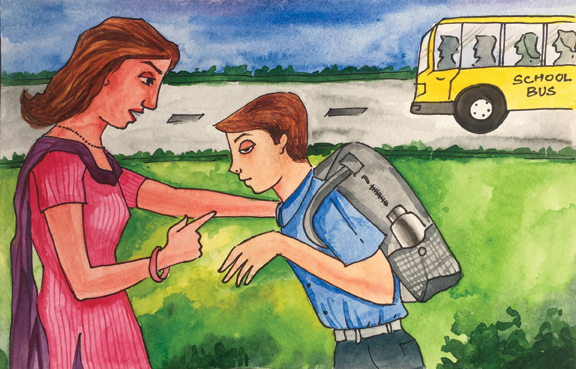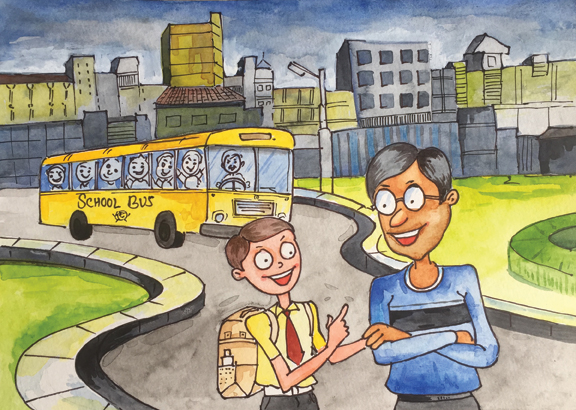Neeraja Raghavan
It was a cool, wintry morning. Traffic was busy as always, even at half past seven. I was waiting at the bus stop for my ride to work. Standing beside me was an anxious young mother with her obviously tired nine-year-old son. Weighed down by his heavy satchel, the boy’s eyes were drooping with inadequate sleep. And yet, his mother was persistently quizzing him on the facts and definitions that he was likely to be asked in today’s EVS test. Hardly pausing for breath, she continued the volley until the yellow bus arrived, when she quickly bundled her tense boy in, with a few more last minute: “Don’t forget …” instructions. Watching this nervous exchange (mostly one-sided, as the boy was too dazed to respond), I didn’t know who to empathize with more: the mother or the child? Or to blame it all on our education system which packages science into neat facts that are simply to be regurgitated in the examination?

What is science, anyway? How do we visualize a scientist?
What are scientists like?
“Close your eyes. Picture a scientist. Now open your eyes and tell me what you saw.”
I have often played this quick game with children – even adults. More often than not, they report images of an Einstein – like figure – with, perhaps, a test tube in hand – hair all awry, white coat in place, some fumes in the background of a messy laboratory … and needless to say, the figure is always male – nearly always, if I count a singular exception!
Then I ask a more basic question: does everyone need science? What about artists, fabric designers, social scientists, playwrights, poets and actors? Do they really need to plough through those compulsory years of memorizing the properties of carbon or Archimedes’ principle? Or is there a way of thinking that science imparts, which everyone can do with?
Why do we teach whatever we teach in the name of “science”? What is our purpose? If the NCERT documents are anything to go by (see below), the ability to define, name or remember facts is conspicuous by its absence. And yet, how often has your child come home after a science test, rueing that (s)he ‘wrote the wrong definition’ or ‘got the wrong result in the experiment’? The emphasis on ‘getting it right’ blots out any urge to think about why a sequence of steps led to the result that they did.
| Curricular expectations As per the EVS curriculum, children at the primary stage are expected to: • acquire awareness about immediate/wider surroundings through lived experiences on various themes related to daily life, e.g., family, plants, animals, food, water, travel, shelter, etc. • nurture natural curiosity and creativity for the immediate surroundings. • develop various processes/skills, e.g., observation, discussion, explanation, experimentation, logical reasoning through interaction with immediate surroundings. • develop sensitivity for the natural, physical and human resources in the immediate environment. Point out and raise issues related to equality, justice and respect for human dignity and rights. Source: https: //ncert.nic.in/pdf/publication/otherpublications/tilops101.pdf |
Curricular material
By far, a teacher’s most-used resources are textbooks – which are certainly far more appealing today than they were three or four decades ago. What hasn’t changed, though, is that they are written to ‘cover’ the prescribed syllabus. The swift changeover from lofty aims (as those spelt out in the textbox below) to a steady focus on facts, facts and more facts is almost compulsive. In fact, it is hardly noticed! No doubt, there are sections like “Things to Do”, “Find out this!” at the end of each chapter. But in the rush to ‘cover the syllabus’ (which is in fact done so effectively that it does indeed get covered in a blur in the student’s mind!), all but a few teachers gloss over these sections. After all, these are not the points that students will finally be examined on! It is far more important that they know the botanical names of plants and get the right answer for acceleration due to gravity – when they perform the experiment with the simple pendulum – during the practical exam! So the familiar Damocles sword (examinations) that hangs over the students’, teachers’ and parents’ heads determines the course of this mad race. These are, pretty much, the main reasons why the focus on process skills like those described in the NCERT document get swiftly taken over by dry facts.
But – is that all that gets lost?
What gets lost?
In the same NCERT document, suggested pedagogical processes for grade VIII (see textbox below) are full of verbs: explore, pose questions, analyze, etc. In contrast, typical assessments contain mostly factual questions where the only ‘doing’ demanded of the student is remembering. Further, there is one very interesting learning outcome for the upper primary stage: appreciation for historical aspects of evolution of science. Some textbooks try and meet this expectation by peppering chapters with little textboxes that contain a perfunctory three-to-four lines about the scientists behind some discoveries.
| The learner is to be provided with opportunities in pairs/groups/ individually in an inclusive setup and encouraged to – • explore surroundings, natural processes, phenomena using senses, viz., seeing, touching, tasting, smelling, hearing. • pose questions and find answers through reflection, discussion, designing and performing appropriate activities, role plays, debates, use of ICT, etc. • record the observations during the activity, experiments, surveys, field trips, etc. • analyze recorded data, interpret results and draw inference/make generalizations and share findings with peers and adults. • exhibit creativity presenting novel ideas, new designs/patterns, improvization, etc. • internalize, acquire and appreciate values such as cooperation, collaboration, honest reporting, judicious use of resources, etc. Source: https://ncert.nic.in/pdf/publication/otherpublications/tilops101.pdf |
In my view, this is like serving the main meal as a side dish! For the fascinating biographies of scientists carry in them almost all the excellently drafted (but seldom realized) learning outcomes in our curricular documents! As we unearth several mistaken beliefs that scientists revisited over the years, we marvel at the ways in which they toppled them. A very contextual example is the story of a Hungarian physician, Semmelweiss. In 1847, it was commonly believed that air transfers infection, so washing of hands was not mandatory. Semmelweiss discovered that touch transfers infection. Had it not been for someone like him1, we would not be protecting ourselves during this pandemic by washing our hands!
As we learn how they made discoveries that changed our worldview, we see that not every scientist was from a privileged background. The Dutch janitor who developed a passion for grinding lenses turned into the Father of Microbiology – Leeuwenhoek. Telling the story of his life to young children is a sure-shot way of exciting them about the way anyone can take a closer look at things around them – and the multiple doors that are thrown open as a consequence of deep observation! Teachers who employ this pedagogy will not have to separately devise activities to “nurture natural curiosity and creativity for the immediate surroundings”. In fact, most of the pedagogical processes listed above will happen organically, if the storytelling is engaging. Hardly any child will not be provoked to look around, ask and even think about the immediate surroundings, after listening to such a story.
Does this really work?
Where is the evidence that this pedagogy2 works? You may well ask.
A group of teachers across India is presently engaged in crafting stories out of scientists’ biographies and trying these out with children of grades I to VIII. [This writer is part of that group.] Here is one testimonial from Krithika Bharath, who taught her second graders about air, and told them the story of Torricelli3. In her own words:
Whether scientists’ biographies (not to forget the heavy concepts they worked on) would be too much for 6-7 year-olds to hear – let alone get inspired by and reflect upon later – was my fear. Post the narration and interaction, my fears were shattered. To my surprise, my class of students was more engaged than ever, throughout the story narration – whether they followed every bit is uncertain. They were involved, asked and answered questions with their understanding (prior, as well as what was getting evident through the story). It was heart-warming to watch them animatedly guess answers and try experimenting to validate their guesses. The eureka moment that Torricelli would have probably had when it struck him that invisible air was pushing the mercury up the tube, was visible in the eyes of my children! What more could I have asked for?!
Some of the questions that her storytelling generated are shown in the textbox below.
| “Why is air everywhere?” “Why is mercury heavier than water?” “How did Torricelli do all this? He must have been sooo intelligent!” “How was water formed?” “Why does a bubble pop?” “I want to become an astro-geologist and study the rocks on other planets.” One child spontaneously tried an experiment to determine whether air has weight by blowing on water and seeing if it rises. She was ecstatic when she saw water rise up on being blown at and excitedly exclaimed,“It really rises!… It rose up and hit my glasses.” Another child wanted to try a parachute experiment again (done in grade I) and observe the effect of air on a parachute. When we were exploring why mercury did not fall off completely, one child said, “It’s probably so heavy that something keeps holding it up against gravity.” “Why does gravity differ in different planets and moons?” “Were things really invented?” One child ran to get a fat encyclopaedia and declared: “I am going to read this!” “I just feel so good after hearing this story.” |

Alternative conversations – other ways of learning science
Imagine this sight in the future: a parent excitedly tells their child a story as they wait together for the school bus! And perhaps, the child shares with great excitement how a scientist made a particular discovery and articulates all the questions that this story raised in the child’s mind. Chances are that such a conversation will be so exciting that they will miss that school bus – but board a far better one that will take them both on an exciting journey of collaborative learning!
- Sadly, instead of being lauded for his life-saving discovery, Semmelweiss’s work was not appreciated until half a century after his tragic death in a mental asylum.
- For more on this pedagogy, watch this webinar titled TEACHING SCIENCE AS A WAY OF THINKING: https://www.youtube.com/watch?v=bKimKwfxtmw
- https://thinkingteacher.in/torricelli-the-man-who-achieved-the-impossible/
The author is founder-director of Thinking Teacher (www.thinkingteacher.in), an organization that networks with teachers across the country. Thinking Teacher aims to awaken and nurture the reflective practitioner within each teacher. Thinking Teacher’s goal is to help build deep inquiry and rich learning into the teaching process. The author can be reached atneeraja@thinkingteacher.in.
